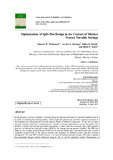Optimization of Split-Plot Design in the Context of Mixture Process Variable Settings

View/
Date
2021-04Author
Wanyonyi, S. W.
Ayubu, Anapapa O.
Koech, J. K.
Korir, B. C.
Metadata
Show full item recordAbstract
In the presence of process variables, a mixture design has become well-known in statistical modeling due to its utility in modeling the blending surface, which empirically predicts any mixture's response and serves as the foundation for optimizing the expected response blends of different components. In the most common practical situation involving a mixture-process variable, restricted randomization occurs frequently. This problem is solved when the split-plot layout arrangement is used within the constraints. This study's primary goal was to find the best split-plot design (SPD) for the settings mixture-process variables. The SPD was made up of a simplex centroid design (SCD) of four mixture blends and a factorial design with a central composite design (CCD) of the process variable and compared six different context split-plot structure arrangement. We used JMP software version 15 to create D-optimal split-plot designs. The study compared the constructed designs' relative efficiency using A-, D-, I-, and G- optimality criteria. Furthermore, a graphical technique (fraction of design space plot) was used to display, explain, and evaluate experimental designs' performance in terms of precision of the six designs' variance prediction properties. We discovered that arranging subplots with more SCD points than pure mixture design points within SPD with two high process variables is more helpful and provides more precise parameter estimates. We recommend using SPDs in experiments involving mixture process settings developments to measure the mixture components' interaction effects and the processing conditions. Also, the investigation should be set up at each of the points of a factorial design.
URI
https://www.researchgate.net/publication/351009148_Optimization_of_Split-Plot_Design_in_the_Context_of_Mixture_Process_Variable_Settingshttps://www.journalajpas.com/index.php/AJPAS/article/view/30285
http://hdl.handle.net/123456789/4622
Collections
- Journal Articles (PAS) [285]
